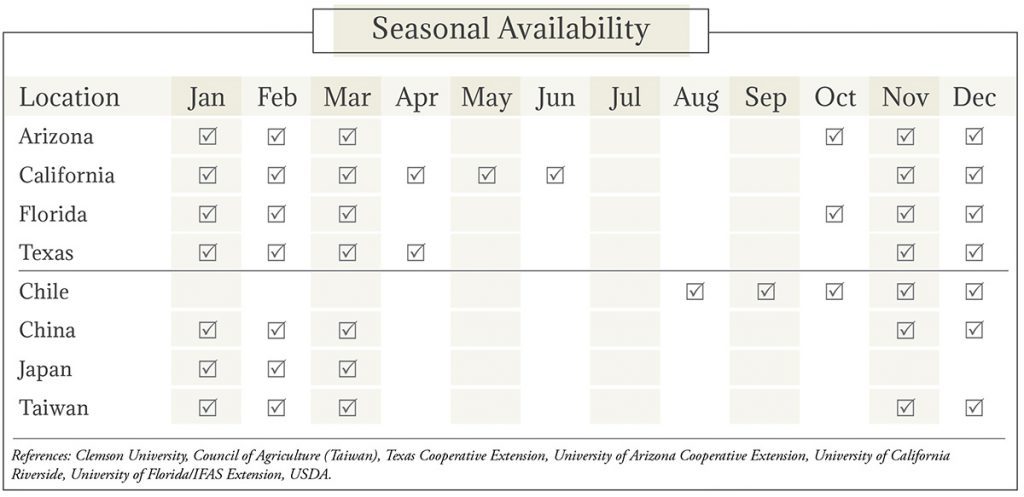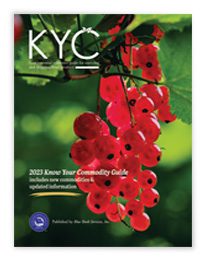Kumquat Market Summary


Image: Alexander Sherstobitov Acevedo/Shutterstock.com
Kumquat Market Overview
Native to Southeast China and Malaysia, the kumquat part of the Rutaceae flowering tree family and has been called “the little gem” of the citrus family. Fittingly, the word kamkwat in Cantonese combines the words for golden and tangerine. The kumquat earns this name as a petite (just 1 to 2 inches in diameter) bright yellow to orange glossy fruit. Kumquats are often grown ornamentally, as their pleasingly bright, shiny, dark green leaves and white flowers are as attractive and popular as the fruit. The fruit itself is generally sparsely seeded, segmented, and not particularly juicy. Quite tart, kumquats may have a hint of sweetness and can be eaten fresh, but seedless varieties are more often made into jams, jellies, marmalades, desserts, candies, liqueurs, and cocktails. Kumquats are the only citrus fruit that can be eaten whole. Depending upon variety, the rind can be far sweeter than the flesh. The fruit contains fiber, iron, calcium, potassium, as well as Vitamins A and C.
Types & Varieties of Kumquats
Kumquats can be oval shaped (Fortunella margarita) or round (Fortunella japonica) and are commonly classified with other small or ‘miniature’ oranges such as calamondins. Rather than being referred to as cultivars, kumquats are distinguished as botanical species. While both round and oval kumquats are grown in the United States, oval varieties are slightly more popular. For oval species, Nagami is the most popular with an acidic fruit and sweet rind. The Nordmann Seedless is a descendant of Nagami, though more elongated and with thinner skin. Though it was first grown in Florida, it is now cultivated in small quantities in California. For round species, Meiwa has a sweet rind and sweet flesh. Puchimaru is similar to Meiwa and seedless. Marumi is also round, but is generally smaller and has a more acidic flesh. Fukushu, a hybrid of Meiwa and Marumi, and also called the Jiangsu kumquat, has a slightly thinner rind. The Hong Kong type, which is also round, is grown commercially (often under the name Golden Bean), but also grows wild. Th fruit is quite small with large seeds and is very tart. They are widely popular in China, but considered more of an ornamental plant in Western countries. Other types include the lesser known and rare Malayan, believed by some botanists to actually be a limequat, or a hybrid between a key lime and a wild kumquat growing in Malaysia. Kumquats are a frequent choice for hybridization. Breeding the tiny fruit with other types of citrus has created many unique fruits, including sunquats (Meyer lemons combined with kumquats), limequats (key limes), orangequats (Satsumas), and citrangequats (citranges).

Cultivation of Kumquats
The subtropical kumquat is one of the more frost-resistant plants in the citrus family. Kumquat trees are able to withstand temperatures as low as 15°F and mild frost without serious injury. The kumquat can be planted from low elevations to about 5,000 feet and young trees benefit from shading until they are well established. Height varies depending on species, but kumquat trees regardless of type rarely surpass 15 feet and are known to be slow growing. A difference from other citrus fruits is that the kumquat enters a period of winter dormancy so profound that shoots or blossoms may not emerge until several weeks of warmer weather have passed. Although kumquats can survive in cooler regions, such as around San Francisco, the fruit tends to be smaller and less sweet than in warmer regions. Cultivation is similar to that of other citrus fruits. The trees are shallow rooted and do well in sandy, loamy or clay soils with appropriate drainage. Kumquats, due to their small size, can also be grown in large containers or pots. In contrast to their frost-resistance, kumquats a period of high temperatures, ranging from 80° to 100°F for trees to actually fruit. The fruit is harvested when bright orange and ripe. In Florida, it is often customary to harvest fruit along with 2 to 3 leaves on the stem; this practice is rare in California and cooler climes where the trees are not as hardy and unable to withstand such leaf loss. Florida is also home to the annual Kumquat festival, held near Miami.

